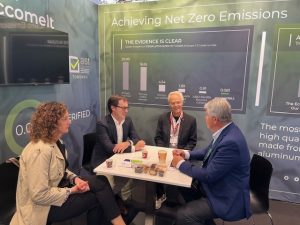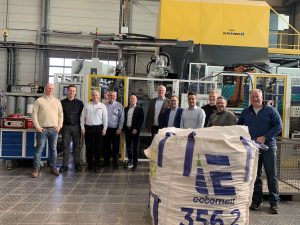Last week, the Eccomelt team participated at the Platts Aluminum Symposium in Miami, FL. The event was very well attended and offered participants a great networking opportunity and a chance to discuss the current state of the aluminum industry and what to expect for this year. Here are some of the highlights of the Symposium:
In a general presentation about the economy, Beth Ann Bovino from S&P Global explained the significant challenges ahead of us, including a “classic overheating economy with macro imbalances” in the US. Ms. Bovino reassured us that the situation does not look as bad as many had pictured it even at the end of last year. Despite rate hikes, the US economy is still very strong, with inflation now slowly declining and a tight labor market. The Fed will likely still increase interest rates further, but not as much as they have in the past, and we risk a “short-ish recession”. In Europe, however, the economy is less overheated and there is more of a geopolitical risk that could last much longer than anyone would have expected. Inflation is higher and will likely remain longer in Europe than in North America, so the ECB will need to increase interest rates and keep them high for a longer time than in the USA. Economic indicators are mixed and surveys still look rather gloomy, but they are improving. Growth continues to decline this year, but at least for North America only a “shallow recession” is expected. The jobs market will be the deciding factor.
In panels and presentations from (among others) S&P Global and Greg Wittbecker, it was shown that while we see modest improvement in supply chains, they are still far from normal. It can be assumed that on-shoring ,re-shoring and increased local sourcing will continue, and global sourcing will decline. One presenter said we, went from “just in time” to “just in case” with respect to inventory. Mexico is expected to gain the most from this supply chain insecurity in North America, but it is expected that OEMs will pay premiums for US and Canadian made products as a hedge for supply chain volatility.
Aluminum imports into the US for domestic consumption were very strong in 2022, at well over 20 billion US$, and primary aluminum imports in particular are expected to grow even further this year. The USD is currently weakening in external value, which is generally driving commodity prices such as aluminum upwards, which we can already see (although this is only part of the price driver). Last year the aluminum price went down due to fears of a recession, but now we see a drastic increase. Over the last year visible stocks have decreased significantly, and there currently exists a deficit in most regions and globally, putting significant upward pressure on LME and regional premiums. The 2022 aluminum “destocking cycle” (driving by recession fear and price decline) should be ending, and this should increase demand again. In China (the largest market for aluminum production and consumption) power shortages already restrain the supply and now the reopening could exacerbate the situation. Energy prices have been driving up the primary aluminum production cost curve, and according to Goldman Sachs, at an LME of 2300USD/t, 25% of ex-China production was loss-making in Q4/2022 (again, putting pressure on increasing curtailments or closures and therefore increased prices). This has been especially true in Europe, where energy prices had increased the most.
The aluminum industry is being pushed to “go green”, like most other industries, and while primary producers will have to work very hard to reach this goal, recycling was agreed to be the best solution to get us to set targets. We see very uneven regional adoption, with Europe clearly leading the charge. Different sectors diverge in terms of the adoption rate of green aluminum, with the auto-sector in the lead, followed by packaging. According to Mr. Wittbecker, “Premiums for low-carbon primary aluminum must be earned the hard way”[ many consumers see low carbon metal as a] “re-branding exercise for existing processes using legacy energy”, which is why producers investing in new capacity using renewables seem to have an easier time earning the premium. Broader and higher low-carbon premiums will mainly depend on the pace of the EU in pricing carbon punitively (Carbon Boarder Adjustment Mechanism) and how much collaboration there is amongst the major deficit regions in limiting carbon leakage. In several panels, the discussion on “carbon accounting”continued, especially on pre-consumer / in-process scrap,
While the building and construction market for aluminum in the Western World is not looking strong this year, the transportation sector, which is the destination for most aluminum castings, appears to be much better. Electrification is a big driver, and it is not only changing the casting market (most castings currently go into powertrain applications), but is also increasing demand for sheet and extruded products (e.g. battery housings). Extrusion capacity increases are expected to boost billet demand. Rolling capacity is poised for the biggest growth this year since the 1980s. While slab demand is expected to be filled with mostly recycled aluminum (often cast at cast-houses at the rolling mill), extrusion billet demand will come from a mix of primary and secondary aluminum from a multitude of sources. Foundry ingots have traditionally been mainly made from recycled aluminum, with the exception of A356 for wheels and structural castings as well as some other specialty and aerospace alloys, and lately also structural casting alloys for automotive applications. While the traditional secondary foundry alloys like A380 see a volume decline due to vehicle electrification, we see increasing use of recycled aluminum for traditionally primary ingot applications, like wheels and structural castings. Structural castings were presented as the biggest growth area in the foundry industry, with new applications, and also new process technologies (like Rheocasting) emerging. Recycling (especially sorting) technologies are improving but still have a long way to go.
As part of the Eccomelt Team, Dan Bitton, Frank Cicchino and Martin Hartlieb had the opportunity to meet associates and customers in the industry and discuss the tremendous benefits of eccomelt356.2. Made from 100% post-consumer scrap, eccomelt356.2 is the lowest carbon footprint alternative to primary aluminum for foundries and die casters. It is produced locally in the USA and Canada (USMCA), and helps minimize supply chain risks from imports. It has been used for wheels and many structural / safety critical applications for many years, and its use and penetration rate is now quickly increasing. Major component producers and OEMs are increasing its use and securing this precious source of low-carbon metal with long-term agreements.





